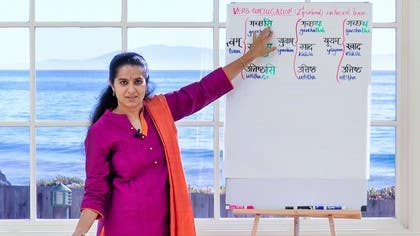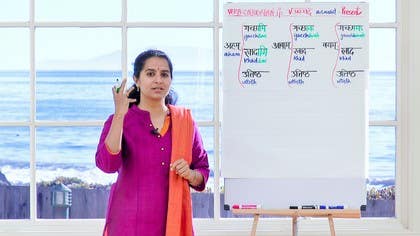Description
About This Video
Transcript
Read Full Transcript
Hi there, Namaste and welcome back to the show again. Welcome Malana. So thus far we have done the verbs in the third person singular, dual, plural and we have looked at the you informal. Next exploring the you in another dimension, we will see what the verb conjugates into when we talk of the you informal in the singular, in the present tense, doing an action. Remember you have to stick with it, patience.
You get a piece of word, you get a verb, you dissect it. Take out as much code as you can from that and you will know who is doing it, how many of them are doing it, when they are doing it. So right now the focus is on you informal, one person, present tense, correct, there we go. Talking of the you formal, just to refresh your memory a little bit, it was Bhavati for the lady. Bhavati, gachati, you go.
Bhavati, gachati, come, Bhavati, agachati, come. Now let's do it in the you informal. The singular you informal pronoun is thwam, thwam, it's quite similar to the to of the French. All right, so thwam, gachasi, gachasi, come, agachasi, thwam, agachasi, eat which is kadati will become kadasi, pibati, pibasi, say that, likati, likasi, great, so likati becomes likasi. Would you like to write something for us, thwam, likasi, great, would you like to drink something for us, thwam, pibasi, quickly I'll run through the different verbs, we'll just do it between us, gachati, gachasi, agachati, agachasi, likati, vadati, vadasi, pibati, pibasi, patati, patasi, upavishati, lovely, upavishasi, uttishtati, uttishtasi.
So the question for the you informal is kim karoshi, thwam, kim karoshi, what would you like to play, kri da si, all right, thwam, kri da si, lovely, or you can play tennis or anything, thwam, kri da si. Now we've done it in the singular, to play with the game of Sanskrit learning we'll do it with the two people, hey, Nicole, welcome on stage, welcome, all right, Nicole, how are you, agachati, now the dual second person is uvam and that's very easy like we saw it in the pronouns to remember because it is you, so if you are an English speaking person it's really easy, it's you, the two of them, uvam, the vam indicates that it's two people doing it, uvam, when one person does it, it is thwam, eat, kar da si, now when two people are eating it becomes uvam, kar da ta, say that, uvam, kar da ta, kar da ta, drink, the two of you drink, pibba si, when only one person is doing it, when two of them are doing it, pibba ta ha, pibba ta ha, when the two of them are writing it, writing something, lika ta ha, lika ta ha, when they're reading, pa ta ta ha, lovely, so did you get a feel of that? It's thwam, kar da si, one person, you, informal, two people, uvam, kar da ta ha, kar da ta ha, the question again would change, it would be uvam, kim kuru ta ha, kim kuru ta ha, so you see the question is already telling us, telling the listener that there are two people, informal, who are doing an action, so just by listening to the ending of the verb, a lot of information is transmitted to the listener, would you like to try doing it in the plural now? So we have kira around, kira, hey kira, welcome mihag also, okay welcome welcome, so we saw it in the singular, thwam, kar da si, in the dual, uvam, the two of them, kar da ta ha, now the plural if you remember is uvam, you stick to the u, that's easy, the yam makes it into the plural, so uvam kar da ta, Sanskrit is a language of precisions, a little breath here and there can change the numbers completely, it's very subtle, so when it's two people, it's kar da ta ha, when it's three or more, it's kar da ta, got that, say that, kar da ta, say it in the dual ones, kar da ta ha and kar da ta, let's do it with gacchati, so when two of them are going, uvam gaccha ta ha, when they are coming it's agaccha ta ha, lovely and now when all the beautiful ladies will walk, it becomes uvam gaccha ta, uvam agaccha ta, lovely, if you want to eat together, it would be uvam kar da ta, lovely, if the question would be what are you doing, kim kuru ta, but maybe I can sound more friendly, what are you doing, kim kuru ta uvam, kim kuru ta, so kar da ta, that's what would be the answer, kar da ta, uyam kar da ta and if they wanted to read together, uyam pa ta ta, I'd love to think that they're reading Sanskrit, so uyam Sanskritam pa ta ta, you plural are reading Sanskrit, fine, so we'll just revise that a little bit, we have tuam gaccha si, uvam gaccha ta ha, uyam gaccha ta, got that, we'll do it with another verb, kar da, tuam kar da si, uvam kar da ta, uyam kar da ta, got that, it will take a little memorization, every language has a certain part of memorization in it, but what I can guarantee you is that once you have learnt the form, it's like mathematics, if you have got the formula straight, you need to memorize the formula, but once you have the formula, you know that any equation within that formula will always be of the same nature, so that's how we go about it, so take some time, practice and it will be easy, promise, thank you very much, thank you.
Mother Tongue: Verbs
Comments
You need to be a subscriber to post a comment.
Please Log In or Create an Account to start your free trial.










